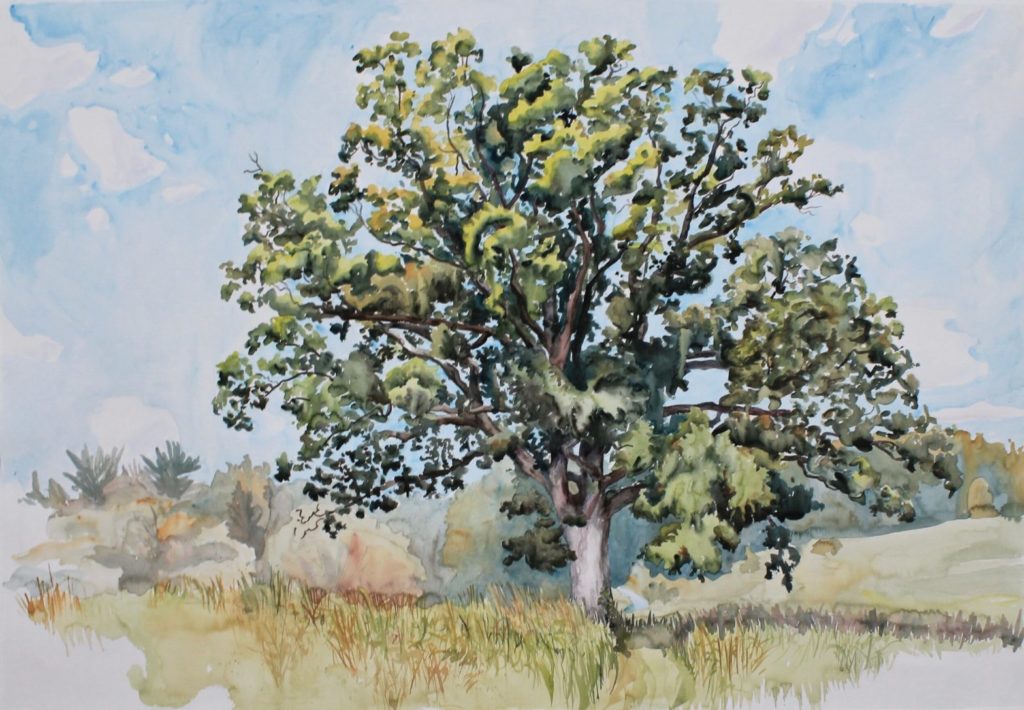The art of Rob Finn is a bittersweet reminder that life is short—even for the oldest of trees.
Over his career as a portraitist of trees, watercolor painter Rob Finn has seen several variations on a peculiar theme. It began a few years ago with a large oak at the Northern California home where Jack London wrote Call of the Wild.
“I loved that tree,” says Finn. “It was gorgeous. The next time I went back, it was gone, because it was going to crush the house. I didn’t know that was going to happen when I took the picture. I didn’t know that when I started the painting.”

Nor did he know it would happen to a 300-year-old oak that he photographed in Brown’s Meadow at Winterthur. “I was interested in about a hundred trees on the estate,” says Finn. When he heard the old giant was destroyed by a tornado in August 2020, he thought, “I have to paint that tree now.”
His portrait of the Brown’s Meadow oak now hangs in the Winterthur Galleries as part of the Transformations installation of works by contemporary artists. The painting depicts what he calls one of his “memorial trees,” images of icons that once were, like another beautiful tree at Winterthur, a Japanese pine that fell in 2021.
“While sitting here looking at all this splendor, trees seem like part of the landscape but they’re living creatures who are only on this earth for a short time, like us,” Finn says. “It’s a very poignant view into the life of a place like this, how it changes, how everyone is trying to preserve it, at least in spirit. You’re not going to have that 250-year-old tree again. It’s a little scary, a little sad, but it’s life. It’s a good way to show folks how sweet and fleeting it is.”
Finn’s career started with two years of study into sculpture and painting at Parsons School of Design in New York City. After taking time off to travel across the county, he enrolled in the College of the Atlantic in Bar Harbor, Maine, where he earned a bachelor’s degree in human ecology. He then moved to San Francisco, where he worked as a painting contractor renovating the famous Victorian houses known as “painted ladies” and occasionally making art.
While in California, Finn began what would become a series of 12 small watercolors that depicted some of his favorite trees. “I found a lot of meat in that subject matter,” Finn says. “I just really got into that. I realized it was more than landscape painting. That’s when I came up with this portrait concept. It’s not just a painting of a tree. It’s a portrait of a character.”
After Finn and his young family moved to Philadelphia in 2017, he was finally able to devote several years exclusively to his art. He later learned of Winterthur’s Maker-Creator Research Fellowship, a program that provides a stipend and gives access to all of Winterthur and some of its staff for research that inspires the work of creative professionals. The 1,000-acre Winterthur property with its variety of tree species was a perfect place to resume the portrait series—in a big way.
“Now most of my paintings are 35 by 52 inches, so they’re as big as a small person,” Finn says. “It’s a whole other thing.”
Unlike most watercolor painters, Finn does not work on a horizontal surface. “I do it on the wall,” he says. “It’s pretty fun to see it happen. The water and the pigment move a lot, but I paint in a way that keeps it from dripping. It’s generally a very controlled dance of danger, making these big pieces.”
Finn is aided in his art by digital photography. When working where there is not enough focal distance for the camera to register an entire tree in one frame, he can photograph it in sections and then assemble them digitally into an undistorted top-to-bottom view for reference in his studio.
“My work is contemporary because these trees couldn’t be painted this way before,” he says. “In close spaces, the artist’s perspective would have been foreshortened from any vantage point. It needs that extra layer of digital editing. I call it new naturalism or synthetic naturalism. It’s not about the piece. It’s about us experiencing the piece.” He pauses, then chuckles. “So it’s good to get the trees up on the wall and let people see them in real life.”
Finn’s work, as well as the work of the other Transformations artists, is currently on view in the Winterthur Galleries.